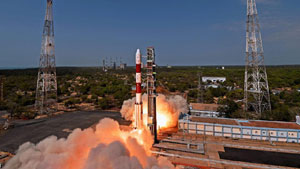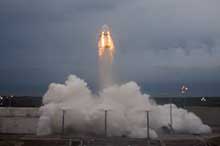March 2019 Science and Technology
Sakshi Education

- ISRO to launch 29 satellites including EMISAT April 1st
India’s Polar Satellite Launch Vehicle (PSLV), in its 47th mission (PSLV-C45), will launch EMISAT, the primary satellite and 28 international customer satellites from Satish Dhawan Space Centre (SDSC) SHAR, Sriharikota. The launch is tentatively scheduled at 0930 Hrs on April 01, 2019, subject to weather conditions.
Weighing about 436 kg, EMISAT based on ISRO’s Indian Mini Satellite -2 (IMS-2) bus platform. The satellite is intended for electromagnetic spectrum measurement.
The PS4 orbital platform is envisaged to provide a microgravity environment for research organisations and academic institutes to perform experiments. In this mission, the PS4 hosts three payloads, namely, Automatic Identification System (AIS) from ISRO, Automatic Packet Repeating System (APRS) from AMSAT (Radio Amateur Satellite Corporation), India and Advanced Retarding Potential Analyzer for Ionospheric Studies (ARIS) from Indian Institute of Space Science and technology (IIST).
The 28 international customer satellites are from four countries, viz. Lithuania, Spain, Switzerland and USA. All these satellites are being launched under commercial arrangements.
- IAF inducts first four heavy-lift Chinook helicopters
Indian Air Force (IAF) formally inducted the four heavy-lift Chinook helicopters Chinook helicopters will be deployed at Chandigarh's Air Force Station 12 Wing.
Chinook Helicopters are capable of vertical lift and heavy lifting in hilly areas.
Vertical lift capability across a diversified terrain was required as India faces multiple security challenges. Chinook has been procured with India-specific enhancements and can carry out military operations even at night, making make these helicopters a national asset.
Another unit of heavy-lift choppers will be created for the East in Dinjan in Assam. The Chinook helicopter has fully integrated digital cockpit management system and is capable of transporting fully-equipped infantry soldiers for specialised operations.
A multi-mission heavy-left transport helicopter, Chinook will be used to move troops, artillery, ammunition, supplies and equipment on the battlefield. Once inducted, the choppers will also help to help to lift M-777 ultra-light howitzers of the Indian armed forces.
Its 24X7, all-weather operational capabilities are crucial for India Air Force, which operates in some of the most hostile terrains in the world.
Apart from military operations, they can also be used for medical evacuation, disaster relief, search and recovery, fire-fighting and civil development.
- Navy's nuclear, biological, chemical training facility launched
Chief of Naval Staff Admiral Sunil Lanba inaugurated the Indian Navy's Nuclear, Biological and Chemical Training Facility (NBCTF) at INS Shivaji in Lonavala.
The NBCTF, christened "Abhedya", impenetrable in Sanskrit, will help train personnel of naval ships fitted with nuclear, biological and chemical detection and protection systems.
The facility will provide realistic training to naval personnel in detection, protection against and decontamination of nuclear, biological and chemical agents.
Admiral Lanba launched the INS Shivaji's website on the Indian Navy portal. He also released the platinum jubilee logo, with the theme "Propelling the Indian Navy since 1945", for the premier technical training establishment.
INS Shivaji is celebrating its platinum jubilee year in 2019-20.
- NASA’s historic all-women spacewalk scrapped due to lack of fitting spacesuits
NASA’s plan to conduct the first all-female spacewalk this month had to be scrapped after the crew aboard the International Space Station encountered an unexpected setback — the lack of well-fitting spacesuits, the U.S. space agency said.
NASA astronauts Anne McClain and Christina Koch were scheduled to conduct the historic spacewalk on March 29 to install powerful lithium-ion batteries for one pair of the station’s solar arrays. Since the space station was assembled in 1998, 214 spacewalks have taken place, all of which had at least one male astronaut.
However, after Ms. McClain conducted her first spacewalk on March 22, she realised that a medium-size hard upper torso — essentially the shirt of the spacesuit — fits her best.
Since only one medium-size torso can be made ready by March 29, Ms. Koch will wear it.
Ms. McClain now is tentatively scheduled to perform her next spacewalk on April 8 with Canadian Space Agency astronaut David Saint-Jacques.
These will be the 215th and 216th spacewalks in the history of International Space Station assembly and maintenance.
During the first spacewalk of the series, on March 22, Ms. McClain became the 13th woman to perform a spacewalk. Ms. Koch will become the 14th on March 29.
No difference exists in a male’s or female’s suit, but female astronaut usually requires a smaller size. The shuttle spacesuit was designed to be made of many interchangeable parts, to accommodate the large number of astronauts with widely varying body sizes. These parts (upper and lower torsos, arms, etc.) are made in different sizes.
- Mission Shakti: India successfully conducts anti-satellite missile test
Defence Research and Development Organisation, DRDO, successfully conducted an Anti-Satellite (A-SAT) missile test, under Mission Shakti from Dr A P J Abdul Kalam Island in Odisha.
A DRDO-developed Ballistic Missile, Defence Interceptor Missile successfully engaged an Indian orbiting target satellite in Low Earth Orbit (LEO) in a Hit to Kill mode.
The interceptor missile was a three-stage missile with two solid rocket boosters.
India has demonstrated anti-satellite missile capability by shooting down a live satellite on a Low Earth Orbit.
An Anti-Satellite Missile (A-SAT) destroyed the live satellite within three minutes.
India has registered herself as a space power and till now only the US, Russia and China have achieved this.
- U.S. takes note of India’s anti-missile test, expresses concern over space debris
The U.S. has said it has taken note of India’s anti-satellite missile test, but expressed concern over the issue of space debris.
The issue of space debris is an important concern for the U.S. government.
Whatever debris that is generated will decay and fall back onto the earth within weeks, it said.
The MEA has also come out with a 10-point explainer to say the anti-satellite missile test was carried out to verify India’s capability to safeguard space assets and that it was not directed against any country.
- Israel unveils world’s longest salt cave
Israeli researchers say they have discovered the world’s longest salt cave near the desert site where, according to the Bible, Lot’s wife was turned into a pillar of salt. It stretches over 10 km, runs through Mount Sodom, Israel’s largest mountain
The 10-km long warren of underground passages and chambers in Mount Sodom, overlooking the Dead Sea, was mapped out over two years by cavers from nine countries, led by the Hebrew University of Jerusalem. The cave is called Malham.
- Humans can detect the earth’s magnetic fields
Scientists have long known that turtles, birds, honeybees and even bacteria can sense the earth’s magnetic field and use them for navigation. But this magneto-reception has hardly been tested in humans and many studies have been inconclusive.
Now a team of researchers from California Institute of Technology, U.S. and the University of Tokyo has shown that humans do indeed unconsciously respond to the changes in the earth’s magnetic fields. But they are yet to decode what our brains may be using this information for.
They selected 34 volunteers, who sat with their eyes closed in a dark room. The room was wrapped with electrical coils, which helped simulate the earth’s natural magnetic field.
The participants were connected to an EEG set-up and their brain activity was monitored. In the one-hour session, for a few minutes, the magnetic field around the chamber was shifted. They noticed that during this period, the alpha power of the brain began to drop.
“When a human brain is unengaged, the alpha power is high. When something catches its attention, consciously or unconsciously, its alpha power drops.”
- Debris from anti-satellite test to disintegrate in 45 days: official
Ballistic Missile Defence (BMD) Interceptor missile being launched by Defence Research and Development Organization (DRDO) in an Anti-Satellite (A-SAT) missile test ‘Mission Shakti’ engaging an Indian orbiting target satellite in Low Earth Orbit (LEO) in a ‘Hit to Kill’ mode from Abdul Kalam Island, Odisha.
U.S. confirms that the 270 pieces don’t pose threat to International Space Station
The satellite targeted with an Anti-Satellite (ASAT) missile under Mission Shakti has broken up into at least 270 pieces, most of which are expected to disintegrate within 45 days.
“The satellite has disintegrated into at least 270 pieces which has also been confirmed by the North American Aerospace Defence Command (NORAD). One of them is a large piece that has been deorbited and is estimated to be completely degraded by April 5,”
Being in the Low Earth Orbit, the debris would fall towards earth and burn up as soon as they enter the atmosphere.
Imaging satellite- The targeted satellite as Microsat-R, an imaging satellite that was launched by the Indian Space Research Organization (ISRO) on January 24 using a Polar Satellite Launch Vehicle. The satellite, weighing 740 kg, was placed in an orbit of 274 km above earth.
- On 27 March 2019, the Defence Research and Development Organization (DRDO) shot down Microsat-R with a modified exo-atmospheric missile of the ballistic missile defence at an altitude of 300 km.
Being monitored- The ASAT test was tracked by sensors of various agencies. Upon impact, data transmission from the satellite stopped and electro-optic systems confirmed an explosion.
- Debris pose significant risk to satellites and other systems launched into orbit as they last for a long time especially in higher orbits. For instance, China’s 2007 ASAT test in an orbit of around 800 km created around 3,000 pieces of debris, of which 616 have decayed. The rest are still in orbit.
- Fossil-rich grounds of Ariyalur in Tamil Nadu
Fossil rock formations at Varanavasi near Ariyalur in Tamil Nadu
At the fork of two roads leading to Sathanur, 62 km from Tiruchi, a rusty signboard stating “Kalmaram Poonga (Fossil Tree Park) points up to the sky.
A woman farmer stacking dried cornstalks on her two-wheeler sets us on the right path to the celebrated petrified tree, a protected monument of the Geological Survey of India (GSI).
Wealth of natural history- These other-wordly outcrops are actually a vast marine graveyard dating back millions of years to the Cretaceous era and the first markers of the wealth of natural history in this area that is spread across at least four districts — Ariyalur, Perambalur, Tiruchi and Cuddalore.
- How: The mouth of the Vellar was considered the entry point of the sea from the Bay of Bengal (a phenomenon called sea ingression). After being a marine haven for 40 million years, the sea evaporated (known as regression), leaving behind a vast graveyard of shellfish, corals, clams, gastropods and branchiopods. These formed huge bands of sedimentary rocks, most of it limestone, the main raw material for cement production.
- What: The region is a magnet for cement companies because of the purity of Ariyalur’s limestone (90% compared to the 67% required for production). The factories burn a mixture of powdered limestone, gypsum, coal and other chemicals to produce cement and clinker (a stony residue).
With fossils lying within easy reach, and no apparent sign of government restrictions on land-use or mining, trading in prehistoric remains is a profitable business here.
- Crew Dragon Rocket launched
 Space X launched an unmanned crew dragon craft from Florida to the International Space Station on 02nd March 2019.
Space X launched an unmanned crew dragon craft from Florida to the International Space Station on 02nd March 2019.
It is milestone for Elon musk’s goal of enabling humans to live on other planets.
Published date : 16 Mar 2019 05:15PM



















